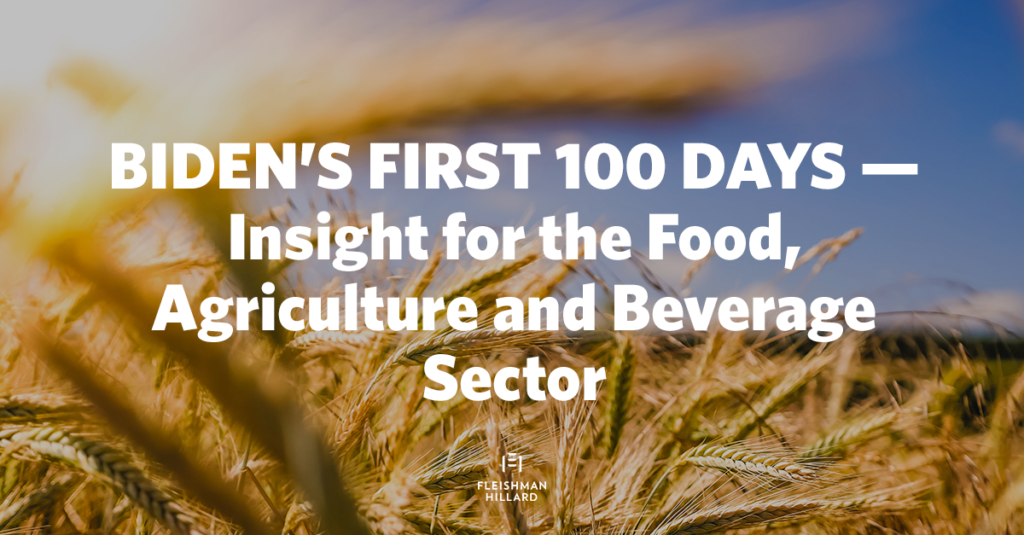Biden’s First 100 Days — Insight for the Food, Agriculture and Beverage Sector
After four years of loosening regulations and lax enforcement, many in the food, beverage and agricultural ecosystem are gearing up for significant regulatory and policy changes under the Biden administration.
The administration’s approach to trade will have far-reaching implications for the sector, and changes in leadership at major federal agencies will certainly lead to new rules and regulations — likely aimed at enacting stricter consumer and worker protections and making food production and agriculture practices more environmentally sustainable.
As the Biden administration approaches its first 100 days, we reflect on what we’ve seen so far, what to expect, and what to look out for down the road.
Sustainability and Climate Action Will be a Predominant Theme
At last week’s Leaders Summit on Climate, President Biden called for cutting U.S. emissions in half by 2030, and has previously pointed to the agriculture industry as a major source of greenhouse gases. The industry plays a central role in Biden’s plan to combat climate change, but the administration has yet to impose limits on the sector’s emissions.
As it stands, the administration seems to be leaning heavily toward financial incentives for producers to adopt climate-friendly practices, verses threatening strict regulation. Agriculture Secretary Tom Vilsack has proposed the establishment of a so-called carbon bank to encourage climate mitigation efforts such as financing sustainable practices or providing a ground floor for pricing sequestered carbon.
Additionally, Environmental Protection Agency (EPA) Administrator Michael Regan has reiterated that agriculture will be an important part of the Biden administration’s approach to tackling climate change, noting the president’s specific focus on biofuels and advanced biofuels. The EPA plans to provide more transparency and certainty though the Renewable Fuel Standard program.
What to look out for: Lots of action at the state level, often at odds with the White House’s agenda.
Global Trade Agenda Still Coming into View
While the Biden’s trade agenda is still in early days, it’s clear that the administration’s approach will be more focused on building coalitions with like-minded partners verses bilateral agreements like his predecessor.
While U.S. political relations with China remain fraught, the country appears to be living up to the agriculture trade purchasing commitments it made under the previous administration, though the final numbers may fall below the original target set due to the pandemic.
What to look out for: It remains to be seen how much Biden’s executive branch will be engaged on trade, versus referring matters to the legislative branch. And, while it’s been suggested, it’s also unclear how quickly the Biden administration would re-engage Trans-Pacific Partnership countries.
Workforce and Labor
Immigration
On day one, Biden sent an immigration proposal to Congress that would have established an earned path to citizenship for 11 million undocumented immigrants. It offers immigrant farmworkers, dreamers and individuals with Temporary Protected Status an expedited path to citizenship and would immediately receive green cards.
As Vice President Kamala Harris begins to untangle the immigration crisis at the southern border, expect more action from the administration on the issue, including involvement from USDA.
Diversity, Equity and Inclusion
After decades of discrimination faced by Black farmers — often denied loans and other financial assistance — at the hands of USDA, the stimulus bill passed in March provided $4 billion in debt relief and an additional billion for severely needed assistance.
Workplace Safety
After missed deadlines, the Occupational Safety and Health Administration has released updated emergency workplace safety rules to prevent the spread of COVID-19. After large-scale coronavirus outbreaks in meatpacking plants early last year, advocates have argued that lack of guidance resulted in employer negligence.
Officials at both the state and federal level have expressed concerns about the ability to quickly and effectively vaccinate farmworkers. Initially hampered by lagging eligibility, now officials are trying to navigate logistical hurdles, high vaccine hesitancy and concerns around immigration status.
What to look out for: In the early days, the Biden administration has been focused on incentivizing change as opposed to regulating it. Depending on how the sector responds, keep an eye on whether that administration trades out carrots for sticks.

